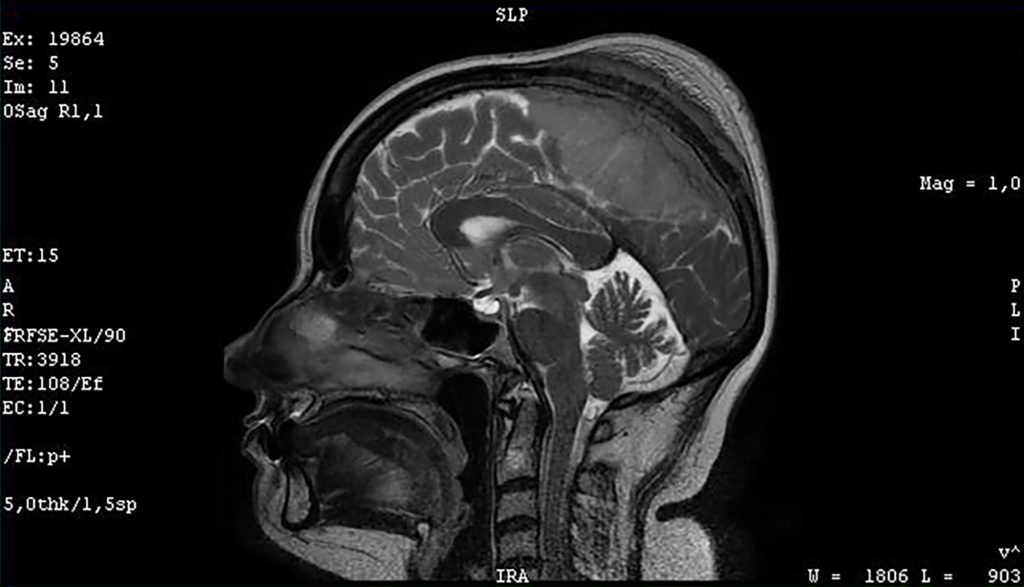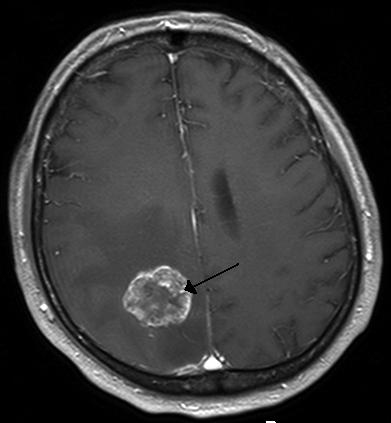11.3: Brain Tumors
A brain tumor is a mass of abnormal cells that form into a growth in the brain. Tumors occur when something goes wrong with genes that regulate cell growth, allowing cells to grow and divide out of control (NINDS, 2023c). Tumors can be noncancerous (benign) or cancerous (malignant). Benign tumors don’t spread to other body parts and often can be removed surgically. Malignant tumors can invade surrounding tissue; some malignant brain tumors can be removed entirely through surgery, whereas others have hard-to-define edges so are difficult to remove completely.
Tumors can also be categorized as primary tumors, which start within the brain, and secondary or metastatic tumors, which are caused by cancer cells that break away from a primary tumor somewhere else in the body and spread to the brain. Metastatic tumors are more common than primary tumors in the brain and occur more often in adults than in children.
Symptoms. Brain tumors cause many different symptoms, and they depend on tumor type, location, size, and rate of growth. In infants, the most obvious sign of a brain tumor is a rapidly widening head or bulging crown (see Figure 3 for an image of a bulging skull in an adult). In older children and adults, a tumor can cause headaches, seizures, balance problems, and personality changes. As with all brain damage and neurological disorders, the effects are location-specific. For example, a tumor in the frontal lobe might contribute to poor cognition or inappropriate social behavior; a tumor in the cerebellum might cause poor balance and movement control; a tumor in emotional regions might cause new bouts of inappropriate laughter or rage. A good friend of author MH reported no symptoms until his face and head swelled up after a flight; an emergency MRI revealed a tennis-ball sized meningioma (a tumor in the meninges surrounding the brain; see Figure 3 for a meningioma in another person). In retrospect, he noted possible coordination deficits, that for example may have caused him to lose to his brother in golf. The tumor was surgically removed and he has resumed “trouncing” his brother in golf.

Diagnosis and Treatment. Diagnosing a brain tumor usually involves a neurological exam with a doctor, lab tests of blood and urine, and diagnostic imaging with magnetic resonance imaging (MRI). MRI scans can provide high-resolution information about tumor cell density and a precise map of the tumor and neighboring structures (see Figure 4 for an MRI scan of a tumor). Surgery is used to obtain tissue for diagnosis and to remove as much tumor as safely possible. Radiation therapy and chemotherapy are often used to kill cancer cells or stop them from spreading. Biological or immunotherapies are being developed to enhance the body’s immune response and to recognize and fight cancer cells. Outcomes for treatments differ greatly based on the tumor type, location, degree of spreading, etc. Malignant glioblastomas, an especially aggressive spreading cancer, usually have poor outcomes (median survival of 14 months; Delgado-Lopez, 2016); while benign meningiomas (non-spreading tumors that develop in the meninges membrane covering the brain) have good outcomes because they haven’t invaded the brain and can be removed surgically.

Text Attributions
This section contains material adapted from:
National Institute of Neurological Disorders and Stroke (NINDS) (2023c). Brain and Spinal Cord Tumors.
https://www.ninds.nih.gov/health-information/disorders/brain-and-spinal-cord-tumors Public Domain.
Media Attributions
- Meningioma of the sagittal sinus © Wikimedia is licensed under a CC0 (Creative Commons Zero) license
- Hirnmetastase © Wikimedia
Tumors that don't spread to other body parts
Tumors that can spread and invade surrounding tissue

